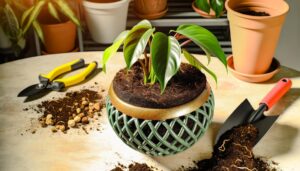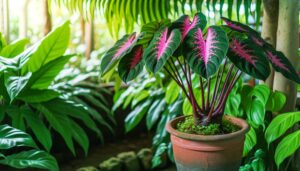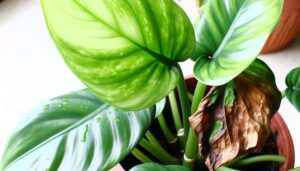What Is Philodendron Gloriosum White Vein?
Philodendron Gloriosum 'White Vein' is a tropical plant species classified under the family Araceae. Originating from Colombia's humid lowland rainforests, it exhibits heart-shaped leaves with symmetrically arranged white veins.
Mature leaves reach up to 90 cm in length, supported by green petioles measuring 30-40 cm. The plant prefers temperatures between 18-27°C and relative humidity levels of 60-80%.
It thrives in soil containing 40% peat, 30% perlite, and 30% orchid bark. This species follows a creeping rhizome growth habit.
For more detailed insights into its care and propagation methods, further information is available.
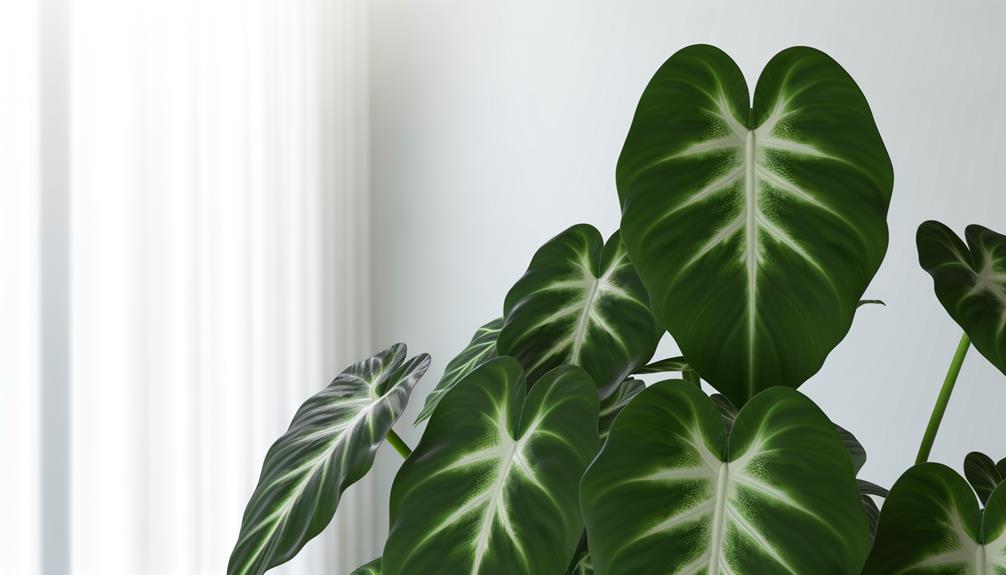
Key Takeaways
- Philodendron Gloriosum White Vein is a tropical plant from Colombia's rainforests.
- It features heart-shaped leaves with prominent white veins and a creeping rhizome growth habit.
- Mature leaves can grow up to 90 cm in length.
- It thrives in humid environments with indirect light and temperatures between 18°C and 27°C.
- Ideal soil mix includes peat, perlite, and orchid bark for optimal root development.
Origin and History

Philodendron Gloriosum White Vein, classified under the family Araceae, originates from the tropical rainforests of Colombia and has a well-documented history within botanical studies due to its distinctive white-veined foliage.
This species, first described scientifically in the early 19th century, thrives in humid, lowland tropical environments. It is a terrestrial plant, preferring to crawl along the forest floor rather than climb. The taxonomic classification places it within the genus Philodendron, known for its morphological diversity and adaptability.
Historical botanical expeditions often highlighted this species due to its aesthetic foliage, which made it a subject of cultivation in botanical gardens worldwide. The precise environmental conditions of its native habitat include high humidity, constant temperatures around 25-30°C, and well-drained, organic-rich soils.
Identifying Features
The defining characteristic of Philodendron Gloriosum White Vein lies in its large, heart-shaped leaves adorned with striking, prominent white veins that create a visually arresting contrast against the deep green foliage. Belonging to the Araceae family, this plant exhibits several unique features:
- Leaf Dimensions: Mature leaves can reach up to 90 cm in length, providing an expansive surface area.
- Vein Pattern: The distinctive white veins are symmetrically arranged, enhancing the ornamental value.
- Growth Habit: Exhibits a creeping rhizome, contributing to its horizontal growth pattern.
- Petiole Anatomy: Features a robust, green petiole measuring approximately 30-40 cm in length, supporting the substantial leaf blade.
These attributes collectively make Philodendron Gloriosum White Vein a remarkable specimen within botany and horticulture.
Ideal Growing Conditions
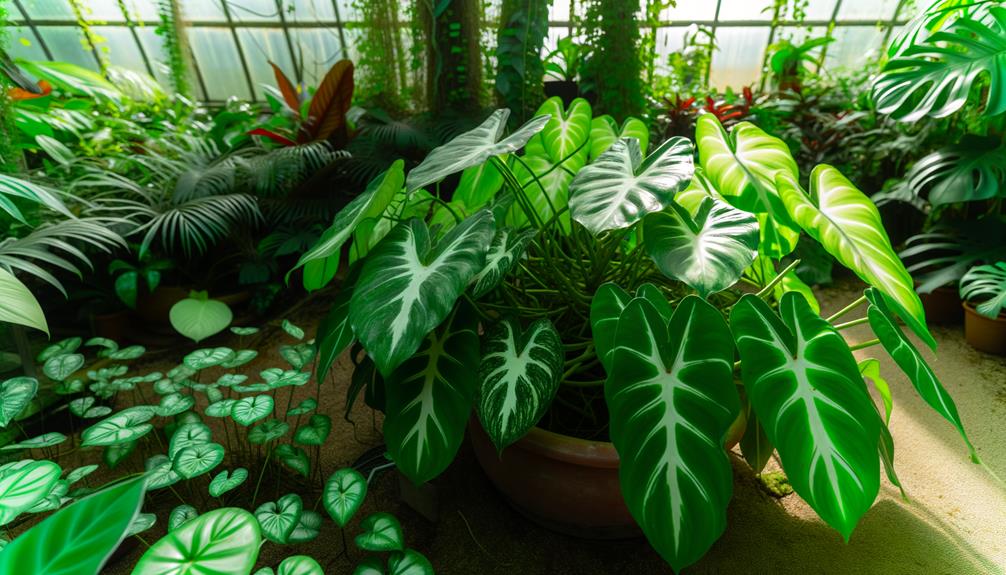
Understanding the unique morphological traits of Philodendron Gloriosum White Vein requires a thorough examination of its best growing conditions to ensure health and growth.
Native to tropical regions, this species thrives in temperatures ranging from 18°C to 27°C. Ideal relative humidity levels should be maintained between 60% and 80%.
Philodendron Gloriosum White Vein (Family: Araceae) requires indirect, diffused light to replicate its natural understory habitat; direct sunlight can cause foliar damage. Airflow is important yet should not result in drafts.
Regular monitoring of environmental parameters is essential. Additionally, it is recommended to maintain a consistent watering schedule, allowing the top 2-3 cm of the substrate to dry out between waterings to prevent root rot and other fungal infections.
Soil and Potting Needs
Philodendron gloriosum, a member of the Araceae family, thrives in a soil composition that guarantees sufficient aeration and moisture retention. This typically consists of 40% peat, 30% perlite, and 30% orchid bark.
Pot size should be carefully chosen to accommodate the plant's rhizomatic growth pattern. It is suggested to use a pot with a diameter of 20-25 cm to allow for expansion.
Proper soil and potting arrangements are essential for the best root development and overall plant health.
Ideal Soil Composition
Selecting the top soil composition for Philodendron Gloriosum White Vein involves a well-draining, aerated mix rich in organic matter. This ensures best root health and mimics the natural habitat of this Araceae family member.
A recommended soil mix should comprise the following components:
- Peat moss (30%): Provides moisture retention and acidic pH.
- Perlite (20%): Enhances aeration and drainage.
- Orchid bark (25%): Mimics the plant's epiphytic nature, offering structural stability.
- Compost (25%): Supplies essential nutrients and organic matter.
The combination of these ingredients fosters an environment that supports the Philodendron Gloriosum White Vein's growth requirements, promoting robust root development and overall plant vigor. This balanced composition is crucial for maintaining the physiological and morphological integrity of the plant.
Pot Size Recommendations
Given the best soil composition, determining the appropriate pot size for Philodendron Gloriosum White Vein is important for accommodating its rhizomatic growth and preventing root congestion.
Philodendron gloriosum, a member of the Araceae family, requires a pot diameter of at least 30-40 cm to support its expansive root system. The pot depth should be approximately 20-25 cm to facilitate adequate drainage and aeration, critical for preventing root rot. Utilizing a pot with drainage holes is crucial to make sure excess water can escape, thereby maintaining ideal soil moisture levels.
Repotting every 1-2 years, or when the roots outgrow the current container, is recommended to provide sufficient space for continued growth and health of this striking aroid species.
Watering Guidelines
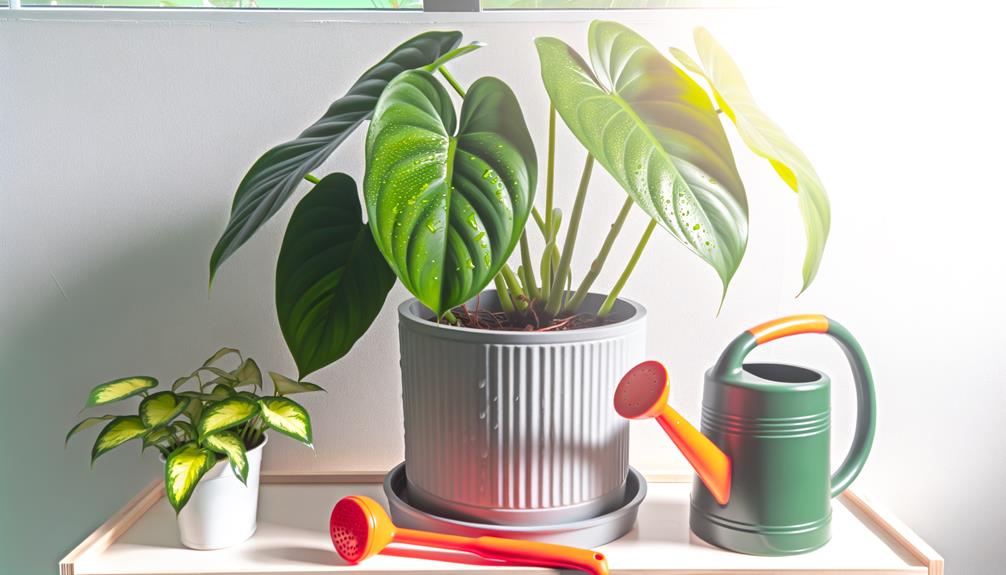
Best hydration for Philodendron gloriosum, a member of the Araceae family, necessitates maintaining consistently moist but not waterlogged substrates, ideally using a soil moisture meter to guarantee precise measurements. This plant thrives in high-humidity environments, with relative humidity levels between 60% and 80%.
Best watering practices include:
- Frequency: Water the plant when the top 2-3 cm of soil is dry.
- Method: Utilize bottom watering to ensure consistent moisture distribution.
- Water Quality: Use distilled or rainwater to avoid mineral buildup.
- Temperature: Ensure water temperature is between 18°C to 24°C to prevent shock.
Adhering to these guidelines promotes robust growth and minimizes the risk of root rot, a common issue in inadequately watered Philodendron gloriosum.
Common Pests and Issues
While maintaining ideal hydration is essential for healthy Philodendron gloriosum, it is equally important to recognize and manage common pests and issues that may compromise its well-being.
The most prevalent pests include aphids (Aphidoidea), spider mites (Tetranychidae), and mealybugs (Pseudococcidae). These pests can cause chlorosis, stunted growth, and necrosis. Regular inspection and early identification are crucial for effective management.
Additionally, fungal pathogens such as Phytophthora and Pythium spp. can induce root rot, particularly in waterlogged conditions. Implementing integrated pest management (IPM) strategies, such as biological controls (e.g., predatory insects) and chemical treatments (e.g., neem oil), can mitigate these threats.
Maintaining a well-drained substrate and ideal humidity levels (40-60%) further aids in preventing infestations and infections.
Propagation Tips
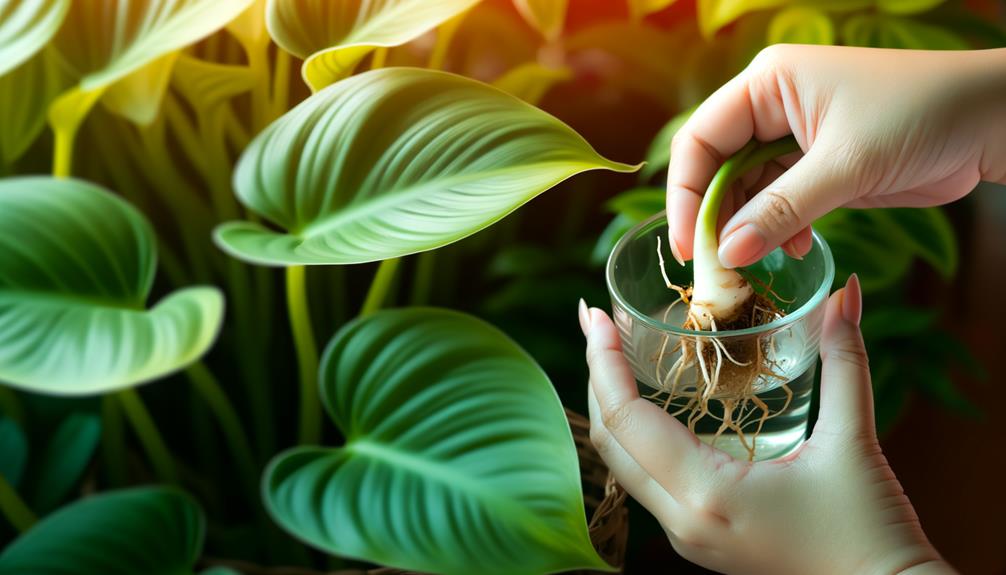
Propagation of Philodendron Gloriosum White Vein (Philodendron gloriosum) can be effectively achieved through methods such as rooting in water and leaf node cuttings.
Utilizing a sterile cutting tool, excise a segment with at least one node and place it in distilled water, ensuring the node is submerged by approximately 2 centimeters.
Maintain ideal environmental conditions, including a temperature range of 22-25°C and indirect light, to facilitate root development within 4 to 6 weeks.
Rooting in Water
To successfully root Philodendron Gloriosum White Vein in water, it is essential to select a healthy stem cutting with at least one node and a few aerial roots. Philodendron gloriosum, belonging to the Araceae family, requires meticulous care during propagation to ensure peak root development.
Submerge the node in water, maintaining a temperature around 22-24°C (71.6-75.2°F), and optimize the aerial roots are partially submerged.
- Water Quality: Use distilled or rainwater to avoid mineral buildup.
- Light Conditions: Place the cutting in indirect sunlight to prevent leaf burn.
- Water Change Frequency: Replace water every 5-7 days to prevent bacterial growth.
- Observation: Monitor root development, expecting visible growth within 2-4 weeks.
These steps will enhance successful rooting and subsequent plant health.
Leaf Node Cutting
For best spread of Philodendron Gloriosum White Vein, selecting a leaf node cutting with at least one healthy node and a few aerial roots is essential. This guarantees optimal growth and establishment.
The ideal cutting should measure approximately 10-15 cm in length, including a mature leaf and an active growth node. Sterilize cutting tools with isopropyl alcohol to prevent pathogen transmission.
Place the cutting in a medium with high humidity and indirect light, such as sphagnum moss or perlite, and maintain a temperature range of 22-25°C. Maintain consistent moisture without waterlogging.
After 4-6 weeks, root development should be observable, indicating successful spread. This method leverages the plant's natural asexual reproduction capabilities, ensuring genetic consistency.
Conclusion
Philodendron gloriosum white vein, with its striking veining and unique morphological characteristics, exemplifies the diversity within the Araceae family. When cultivated under ideal conditions – well-draining soil, regular moisture, and indirect light – this species thrives.
However, what does its successful propagation imply for conservation efforts and botanical study? Addressing common pests and issues further confirms its preservation.
Ultimately, the Philodendron gloriosum white vein serves as a proof to the intricate beauty and complexity inherent in plant biology.


